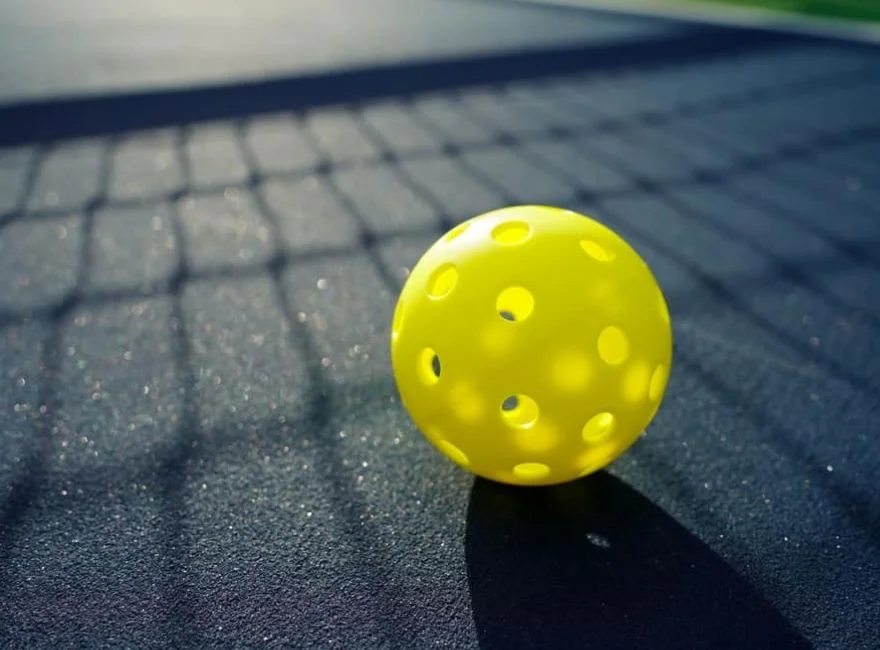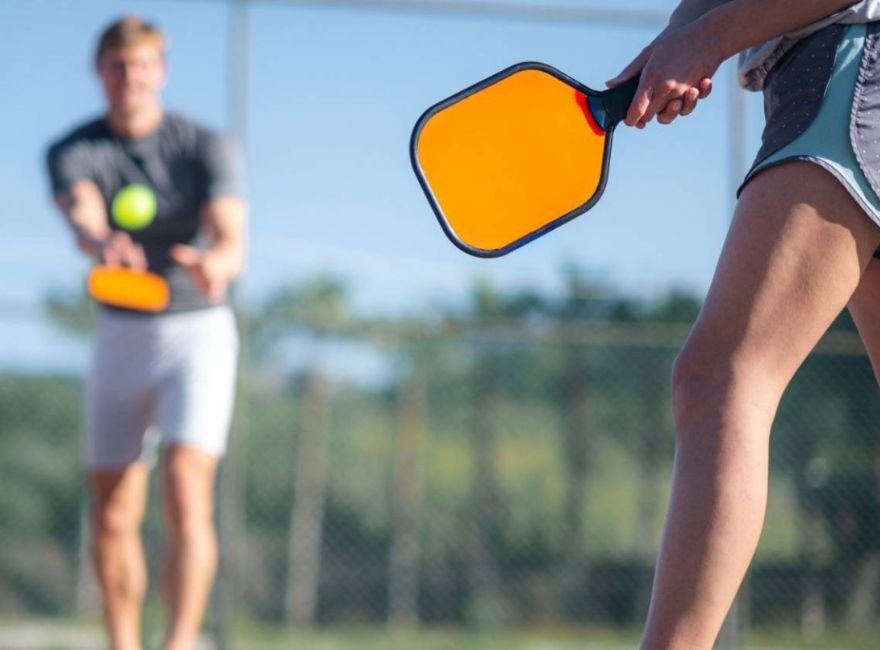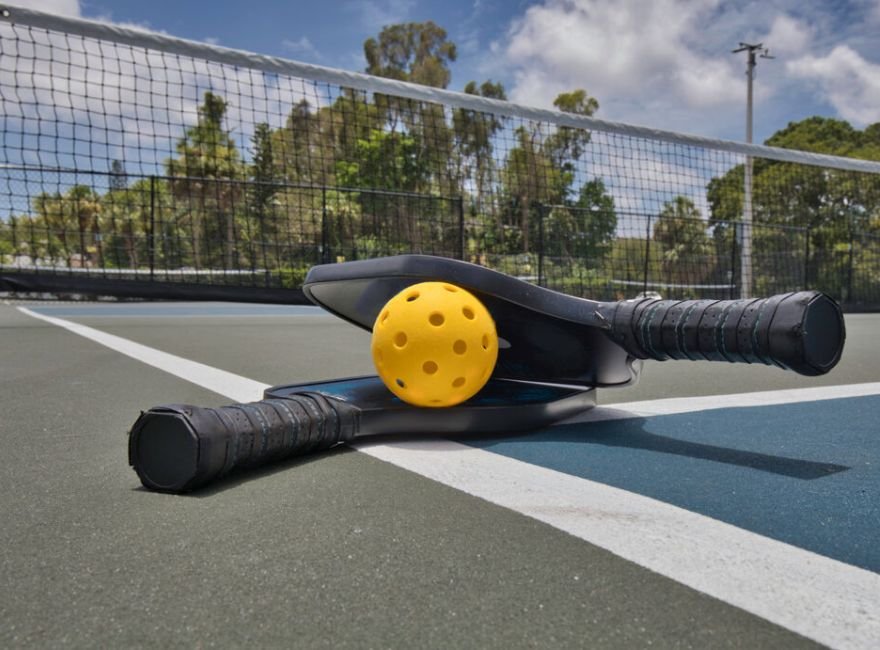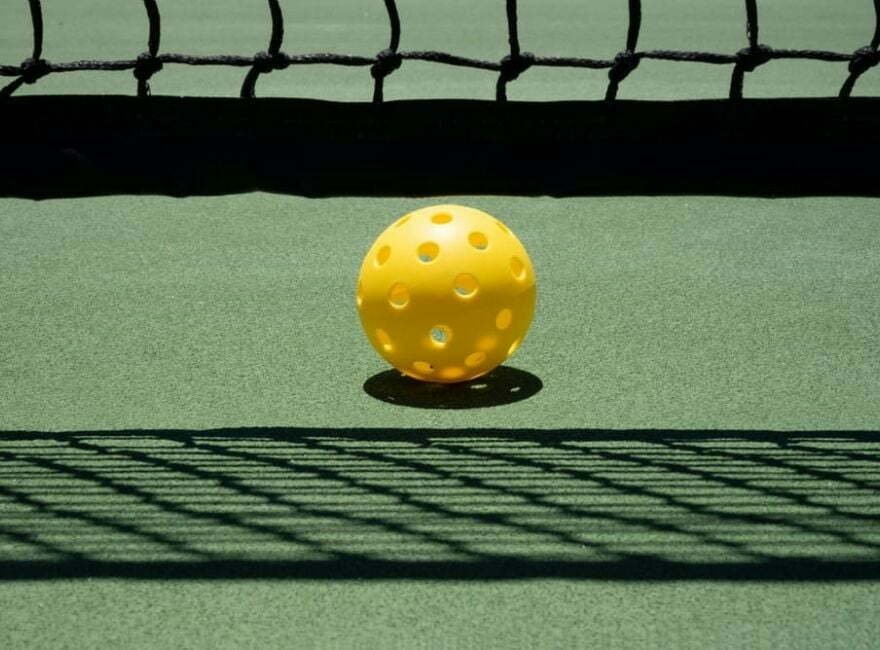What Does A Pickleball Look Like?

As people get more into playing pickleball and really focus on improving their skills, they start thinking about the heart of the game – the pickleball itself.
Ever wondered why a pickleball is special? How do its characteristics change the game for us? Let’s dig into the mysteries of this simple ball that makes our beloved sport happen.
As we unravel these secrets, you’ll gain a fresh understanding of the details of pickleball and be all set to have an even better game!
Click here to read our blog post covering all aspects of “An Introduction To Pickleball“.
The Essence of a Pickleball

The Basics: Pickleballs, those little orbs that bring joy to the court, have a story written in their dimensions. Picture this: a standard pickleball, not too big and not too heavy, measuring 2.87 inches (7.3 cm) in diameter and tipping the scales at a mere 0.88 ounces (25 grams). Now, these numbers might seem like random facts, but in the game of pickleball, they’re the silent architects of every play.
The colors: In the vibrant world of pickleball, color isn’t just a cosmetic choice; it’s a strategic decision. Most pickleballs dress in either white or bright yellow attire, ensuring they stand out against the court backdrop. Why this color palette? Well, it’s all about visibility. Just like tennis balls flaunt their sunny yellow shade for optimal visibility, pickleballs follow suit. It turns out, a pop of color helps players keep their eye on the prize, or in this case, the ball.
Materials Matter: Now, let’s dive into the material universe of pickleballs. Picture a sturdy plastic called polypropylene, the hero of pickleball construction. The signature look? Think wiffle ball chic – a surface peppered with tiny holes. These holes are not just for show; they’re the unsung heroes of the pickleball chronicles.
Feel the Texture: Caress the surface of a pickleball, and you’ll feel its texture speak volumes. Smooth as silk or rough around the edges, this tactile quality isn’t just for your fingertips. It’s a game-changer on the court. A smooth texture lets the ball glide effortlessly through the air, while a rougher one adds a touch of drama with increased drag, spin, and bounce.
In a research symphony conducted by the United States Pickleball Association (USAPA), the texture and holes on a pickleball emerged as the conductors of its flight and bounce orchestra.
Secrets Behind the Game

Ever wondered about those tiny holes on a pickleball? They’re not just there for decoration; they play a crucial role in the game. These perforations aren’t just for looks – they have a job to do.
Different balls sport different hole patterns and sizes, and these nuances can throw some curveballs into the mix. A scientific study spilled the beans, revealing that these holes determine not just the flight path of the ball but also its spin and how high it bounces (check out the Sports Engineering Journal if you’re into the nitty-gritty details).
Knowing the science behind these holes isn’t just for the nerdy players – it’s a game-changer. Understanding why the ball acts the way it does helps players become the puppet masters, predicting its every move and planning killer shots. Now, let’s talk about bounce – the rise and fall of a pickleball’s journey. The height of its bounce isn’t a random occurrence; it’s a dance influenced by temperature, wear and tear, and the type of court it’s dancing on.
When it’s chilly, the ball doesn’t bounce as high – blame it on the plastic’s loss of springiness. As a ball ages, its surface gets rougher, and the bounce takes a hit. Courts also have a say in this dance – harder surfaces like concrete make the ball spring higher than the softer embrace of grass or clay.
Researchers, armed with lab coats and a love for the game, found that players who adapted their moves to the ball’s bounce aced their matches (check out the International Journal of Sports Science & Coaching for the full scoop).
Pickleball Appearance

Looking Back: Think about the first pickleball games back in the 1960s. The balls used to be homemade, cobbled together from whatever plastic was lying around or repurposed from other sports gear. But as time passed, things changed. Companies started making pickleballs just for this sport, tweaking the materials, the holes, and the feel to make them perform even better.
Thanks to better materials and clever manufacturing, pickleballs now act in a more expected way when you’re playing. It’s all about consistency and predictability. And as more people fell in love with pickleball, they wanted better gear. That push for quality has kept designers on their toes, always finding ways to make pickleball even more fun to play.
Changes in Pickleball: As we dive into the future of pickleball, get ready for some cool tweaks in the way the pickleball looks and performs. Imagine this: clever minds behind the game might tinker with the stuff that makes the ball, thinking of new materials to make it super strong or playing around with the little holes and textures to make it fly and bounce just right.
It’s like a sneak peek into a world where pickleball gets even more serious and competitive. Players might start picking balls like they’re choosing a superhero with powers that match their game style and strategy. So, brace yourselves, pickleball enthusiasts, because the game is gearing up for a makeover that’s bound to amp up the fun and excitement on the court.
Let’s sum it all up.
The pickleball, with its unassuming appearance, holds the key to a dynamic and ever-evolving game. From the dimensions and color choices that enhance visibility to the materials and textures that shape its performance, the pickleball is a silent maestro orchestrating the symphony of each match.
As players unlock the secrets behind its design, they not only deepen their understanding of the game but also elevate it to an art form where science and strategy dance together on the court.
Looking back at the humble beginnings of homemade pickleballs to the present era of precision design, the journey reflects not just the evolution of equipment but the passion and dedication of a growing community.
Anticipating future innovations, we stand on the cusp of a pickleball renaissance, where the ball’s makeover promises to add new dimensions of excitement and strategy to this beloved sport. The future holds a vibrant canvas where the pickleball continues to be the heart of the game, inspiring players to engage, adapt, and revel in the ever-changing beauty of pickleball.
Finally, let’s have a quicker look at the most frequently asked questions.
What and why is it called pickleball?
Pickleball gets its name from the family dog of one of its inventors, Joel Pritchard. The dog’s name was Pickles, and as the story goes, Pickles would chase after the ball during the game. Hence, the sport became known as pickleball.
What does playing pickleball look like?
Playing pickleball involves a combination of elements from tennis, badminton, and table tennis. It is typically played on a smaller court with a net, using a paddle and a plastic ball with strategically placed holes. The game is fast-paced, and players engage in rallies, trying to score points by sending the ball over the net and into the opponent’s court.
How do you describe pickleball?
Pickleball is a paddle sport that combines elements of various racquet sports. It is played on a smaller court than tennis, making it accessible to players of all ages. The game involves quick movements, strategic plays, and a friendly yet competitive atmosphere. It’s a sport that promotes social interaction while providing a good workout.
Is pickleball like table tennis?
While both pickleball and table tennis involve a paddle and a ball, they differ in terms of court size, playing style, and rules. Pickleball is played on a larger court, and the rules resemble those of tennis, albeit with some unique elements. Table tennis, on the other hand, is played on a smaller table, and the game is more focused on quick reflexes and precise shots across the table.
